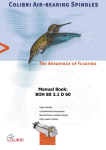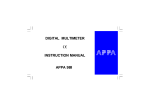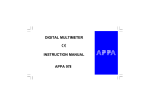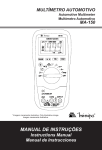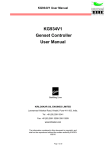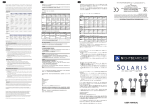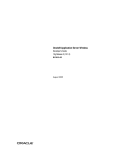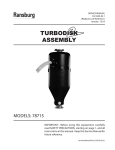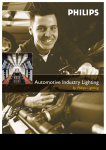Download Colibri Sander BLO 80 2 1 C 30 User's Manual
Transcript
Manual Book: BLO 80 2.1 C 30 Characteristics In most respects aerostatic bearings are ideally suited for use in high-speed machines. Their low friction provides high mechanical efficiency and minimizes bearing heating problems. They are quiet and smooth running and do not add to sound and vibration levels of the machine in the way that high-speed ball bearing do. Applications One of the most important fields of application of aerostatic bearings is undoubtedly on machine tools where the range of machine tool application is very wide. Advantages Almost all of the benefits result from three properties of aerostatic bearings: low friction, precise axis definition, and the absence of wear. In comparison with spindles with ball or roller bearings, the lower level of vibration of aerostatic bearings is an important advantage. This is particularly true in relation to the production of good work piece geometry and surface finish, and in ensuring long life of the cutting tool, drill or grinding wheel. Aerostatic bearings have been employed in machines driven by most types of electric motors and most types of turbines. They have also been employed in a wide range of machine tool spindles driven by various types of belts and flexible couplings. In all these cases the driving torque is evenly and smoothly applied, excepting the case of driving by means of a belt, the drive does not apply large loads to the bearings. Aerostatic bearings are most successful when operating under these conditions. They are much less likely to be successfully applied to machines with pulsating drives, which impose large internal loads on the bearings. CONTENTS 1. Fundamental Safety Instructions. 2. Warranty notice. 3. Attention – Daily Check Before starting the spindle 4. System general description. 5. Aerostatic Spindle Label. 6. Installing the spindle. 7. Removing the spindle from the machine. 8. Specification for High – Speed Air Spindle. 9. Electrical Motor Specification. 10. Brushless DC Motor 11. Diagrams: a) Torque & Power Vs. Rotation Speed b) Final Velocity Vs. Torque & Acceleration Time & External Inertia c) Radial Stiffness Vs. Air Pressure. d) Axial Stiffness Vs. Air Pressure. e) Radial Load Capacity Vs. Air Pressure. f) Axial Load Capacity Vs. Air Pressure. g) No Load Deceleration h) Mechanical Friction Losses. i) Voltage constant j) Current Vs rotation speed k) Torque Vs rotation speed l) Vibration Speed Vs. Rotation Speed. m) Vibration Amplitude Vs. Rotation Speed. n) Power Vs. Current & Rotation Speed. 12. Raw Materials Data. 13. Spindle Modes. 14. Spindle Balancing 15. Electrical System. 16. Thermistor – 104GT-1. 17. Description of a Spindle Testing. 18. Cooling Water Sealing & Flow Test Circuit. 19. Failure, Cause, Prevention 3 5 6 7 7 8 9 10 11 12 13 13 14 14 14 14 14 14 15 15 15 15 15 15 16 17 18 22 23 24 25 26 0 FUNDAMENTAL SAFETY INSTRUCTIONS 1. Basic operation and designated use of the machine. 1.1 1.2 1.3 2. Organizational measures. 2.1 2.2 2.3 2.4 2.5 2.6 2.7 2.8 2.9 2.10 2.11 2.12 2.13 2.14 2.15 2.16 2.17 3. The machine has been built in accordance with state of the art standards and recognized safety rules. Nevertheless, its use may constitute a risk to life and limb of the user and of the third parties, or cause damage to the machine and to other material property. The machine must only be used in technically perfect conditions in accordance with its designated use and the instructions set out in the operation manual. Only safety-conscious persons who are fully aware of the risks involved in operation the machine should operate it. Any functional disorders, especially those affecting the safety the safety of the machine, should therefore be rectified immediately. The machine is designed exclusively for drilling, grinding and milling operations. Using the machine for purposes other than those mentioned above is considered contrary to its designated use. The manufacturer cannot be held liable for any damage resulting from such use. The risk of such misuse lies entirely with the user. Operating the machine within the limits of its designated use also involves observing the instructors set out in the operation manual and complying with the inspection and maintenance directives. The operating instructions must always be at hand at the place of use of the machine. In addition to the operating instructors, observe and instruct the user in all other generally applicable legal and other mandatory regulations relevant to accident prevention and environmental protection. Those compulsory regulations may also deal with the handling of hazardous substances, issuing and/of wearing personal protective equipment. The operations instructions must be supplemented by instructions covering the duties involved in supervising and notifying special organizations, working sequences or the personal entrust with the work. Personal entrust with the work on the machine must have read the operating instructions and in particular the chapter on safety before beginning work. Reading the instructions after work is too late. This applies especially to persons working only occasionally on the machine e.g. during setting up or maintenance. Check whether personal is carrying out the work in compliance with the operation instructions and paying attention to risks and safety factors. For reasons of security, long hair must be tied back or otherwise secured, garment must be close fitting and no jewelry, such as ring, may be worn. Injury must result from being caught up in the machinery or from rings catching on moving parts. Use protective equipment whenever required by the circumstances or by law. Observe all safety instructions and wearing attached to the machine. See to it that safety instructions and wearing attached to the machine are always complete and perfectly legible. In the event of safety-relevant modifications or changes in the behavior of the machine during operation, stop the machine immediately and report the malfunction to the competent person. Never make any modifications, additions or conversions, which might affect safety without the suppliers’ approval. This also applies to the installation and adjustments of safety devices and valves. Spare parts may comply with the technical requirements specified by the manufacturer. Spare parts from original equipment manufacturers can be rely to do so. Never modify the software of programmable control systems. Adhere to prescribe intervals or those specified in the operating instructions for routine checks and inspections. For the execution of maintenance work, tools and workshop equipment adapted to the task on hand are absolutely indispensable. A portable fire extinguisher must be placed within immediate reach. Observe all fire warning and fire-fighting. Selection and qualification of personal-basic responsibilities 3.1 3.2 3.3 3.4 Any work or and with the machine be executed by reliable personnel only. Statutory minimum age limits must be observed. Employ only trained or instructed stuff and set out clearly the individual responsibility of the personnel of operation, set-up, maintenance and repair. Make sure that only authorized personnel work on or with the machine. Define the machine operators’ responsibilities – giving the operator the authority to refuse instructions by third parties that are contrary to safety. 3 3.5 Do not allow persons to be trained or instructed or persons taking part in a general training course to work on or with the machine without being permanently supervised by an experienced person. Work on the electrical system and equipment of the machine must be carried out only by a skilled electrician or by instructed person under the supervision and guidance of a skilled electrician and in accordance with electrical engineering rules and regulations. 3.6 4. Safety instructions governing standard operation 4.1 Avoid any operational mode that might be prejudicial to safety. 4.2 Take the necessary precautions to ensure that the machine is used only when in a safe and reliable state. 4.3 Operate the machine only if all protective and safety oriented devices, such as removable safety devices, emergency shut-off equipment, sound proofing elements and exhausts, are in place and fully functional. 4.4 Check the machine at least once per working shift for obvious damaged and defects. Report any changes (including changes in the machine’s working behavior) to the competent person immediately. If necessary stop the machine immediately and lock it. 4.5 In the event of malfunction, stop the machine immediately and lock it. Have any defects rectified immediately. 4.6 During start-up and shutdown procedures, always watch the indicators in accordance with the operating instructions. 4.7 Before starting up or setting the machine in motion, make sure that nobody is in risk. 4.8 Never switch off or remove suction and ventilation devices when the machine is in operation. 5. Safety instructions governing special work in conjunction with utilization of the machine and maintenance and repair during operation; disposal and consumable parts. 5.1 5.2 5.3 5.4 5.5 5.6 5.7 5.8 5.9 5.10 5.11 5.12 5.13 Observe the adjustment, maintenance and inspection activities and intervals set out in the operation instructions, including information on the replacement if parts and equipment. Skilled personnel may execute those activities only. Brief operation personnel before beginning special operations and maintenance wok, and appoint a person to supervise the activities. If any work concerning the operation, conversing or adjustment of the machine and its safety oriented devises or any work related to maintenance, inspection and repair always observe the start-up and shutdown procedures set out in the operating and the information on maintenance work. Ensure that the maintenance area is adequately secured. If the machine is completely shut-down for maintenance and repair work, it must be secured against inadvertent starting by: - Locking the principal control elements and/or - Attaching the “warning signal” sign to the main switch. To avoid the risk of accidents, individual parts and large assemblies being moved for replacement purposes should be carefully attached to lifting tackle and secured. Use only suitable and technically perfect lifting gear and suspension systems with adequate lifting capacity. Never work or stand under suspended loads. For carrying out overhead assembly work, always use specially designed or otherwise safetyoriented ladders and working platforms. Never use machine parts as a climbing aid. Wear a safety harness when carrying out maintenance work at greater heights. Keep all hardens, steps, handrails, platforms landing and ladders from dirt. Clean the machine especially connections and threaded unions, of any trace of oil, fuel, or preservative before carrying out maintenance. Never use aggressive detergents. Use lint-free cleaning rags. Before cleaning the machine, cove or tape all openings, which for safety and functional rezones, must be protected against water, steam, or detergent penetration. Special care must be taken with electric motors and switchboard cabinets. Always tighten any screwed connections that have been loosened during maintenance work. Any safety devices removed for set-up, maintenance or repair purpose must be ratified and checked immediately upon completion of the maintenance work. Ensure that all consumable and replaced parts are disposed safely and with minimum environmental impact. 6. Warning 6.1 of special dangers: Use only original fuses with the specified current rating. Switch off the machine immediately if trouble occurs in the electrical systems. 4 6.2 6.3 6.4 6.5 6.6 6.7 6.8 Work on the electrical system or equipment may only be carried out by a skilled electrician himself or by specially instructed personnel under the control and supervision of such electrician and in accordance with the applicable electrical engineering rules. If provided for in the regulations, the power supply to parts of machine, on which inspection, maintenance and repair work has to be carried out, must be cut off. Before starting any work, check the de-energized parts for the presents of power and ground or short-circuit in addition to insulating adjacent live parts and elements. The electrical equipment of machine is to be inspected and checked at regular intervals. Defects such as loose connectors or scorched cable must be rectified immediately. Necessary work on live parts and elements must be carried out only in the presence of a second whom can cut off the power supply in case of danger by actuating the emergency shut-off or main power switch. Secure the working area with a red-and-white safety tape and a warning sign. Use insulated tools only. Check all lines, hose and screwed connections regularly for leaks and obvious damage. Repair damage immediately. Depress all system sections and pressure pipes to be removed in accordance with the specific instructions for the unit concerned before carrying out any repair work. Compressed air lines must be laid and fitted promptly. Ensure the no connections are interchanged. The fittings, length and quality of the hoses must comply with the technical requirements. 7. Mobile 7.1 7.2 machinery and equipment Cut off the external power supply of the machine even if only minor changes of place are envisage. Properly reconnect the machine to the supply mains before restarting. For restarting process only in accordance with the operating instructions. WARRANTY NOTICE We warrantee this spindle to be free of material and workshop defects. This warrantee is conditional upon proper use in the applications of which this spindle is designed to. Warrantee is void if damaged caused due to improper use, installation, negligence, accident, inadequate maintenance to the spindle or the machine in which it is installed. This warrant is also void if customer did not follow the complete manual and caused damage. In any case of damage, failure analysis will be perform by Plasel to determine the cause of the failure. Warrant is void if damaged caused by inadequate machine maintenance or improper use ex. Leaky valves, Z-axis leakage wear, contained air supply, lower/higher air presser, inadequate vacuum, using the spindle to work on material that is too hard, drilling into anything other then the right material. 5 ATTENTION DAILY CHECK BEFORE OPERATING THE SPINDLE 1. For first time installation, look at “Installing the spindle” paragraph. 2. Check air supply (5-6 bar.) 3. Check ventilation exits. 4. Check for free movement of the shaft. 5. The spindle must be securely clamped to the machine and clear from any distraction. 6. Check for electric connections and command (community grounding). 7. Start the spindle. 6 SYSTEM GENERAL DESCRIPTION TOP VIEW SIDE VIEW 7 INSTALLING THE SPINDLE 1. Remove the spindle from its package. 2. Follow the machine’s safety and installation instructions. 3. Clamp the spindle to the machine - using 4 screws (M5 - minimal length 15 mm). Note: Locate the spindle on the position pins; 4. 5. 6. 7. Remove plugs from air connections (2). Connect inlet air pipe Ø6 mm to “AIR IN” (AI). Connect outlet air pipe Ø6 mm to “AIR OUT” (AO) or you may use a silencer. Remove black plastic nut from the end of the shaft. 8. Turn air supply on, spin the shaft by hand and make sure that the shaft is rotating freely. 9. Check for air pressure ( 5.5-6.5 [bar].) 10. Check for airflow ( 35-45 [lpm].) 11. Connect power cable to the driver. 12. Turn the driver on and spin the spindle. Start at low speed (1000 rpm for 5 minutes) and slowly increase up to 5 Krpm. 13. Check for motor current at 5000 rpm, less 0.5 Amp. 8 REMOVING THE SPINDLE FROM THE MACHINE Note: Always lift the spindle from the body and not from the shaft. 1. Turn off the spindle. Make sure the shaft has stopped before continuing. 2. Follow the machine’s safety and installation instructions. 3. Disconnect power cable. 4. Disconnect signal cable. 5. Turn off air supply. 6. Disconnect air pipes from the spindle. 7. Remove wheel D-400 (ø65 mm). 8. Remove wheel D-1400 (ø76 mm). 9. Close AO and AI holes with plastic plugs x2. 10. For unclamping the spindle from the machine, screw out M5 screws. 11. Return the spindle to its original package for storing or sending. DISASSEMBLY WHEEL MOUNT RIGHT FROM SPINDLE 9 SPECIFICATION FOR HIGH-SPEED AIR SPINDLE Rotation speed – 2K ~ 75K [rpm] Air supply Pressure Flow rate Filtering Dew point Oil residue Static run-out of the rotor Radial direct. (max) Thrust direct (max) Dynamic run-out of the rotor Radial direct(max) Thrust direct. (max) Radial direct. Fluctuation between peaks Thrust direct. Fluctuation between peaks Rigidity of the rotor Radial direct. Thrust direct. Load capacity Radial direct. Thrust direct. General Shaft Axial Extension @ Tm = 40 [oC] Spindle Weight Rotor Inertia Noise level 0 up to 10 Krpm (max) 100 OM Resistance between shaft & frame Balance:G0.4 @ ISO 1940 CE standard Floating Point :5~7 [bar] :30-40 [lpm] :0.01 [µm] :lower then 15 [ C] :lower then 0.1 [ppm] :0.35 :0.35 [µm] [µm] :1 :1 :0.3 :0.3 [µm] [µm] [µm] [µm] :7 :9 [N/µm] [N/µm] :30 :100 [N] [N] :4 :3 :6 E-5 :70 [µm] [Kg] [Kg*m2] [db])@ :1 [MΩ] :0.03 [gmm] : corresponding :3 [bar] ELECTRICAL MOTOR SPECIFICATION Size Constants: • • • • • • • • • • • • • • • • • • • • • • • • • • Maximum Rated Torque Maximum Continuous Stall Torque @ Temp. Rise 100 [ºC] Motor Constant Electrical Time Constant Mechanical Time Constant Angular Acceleration (theoretical) Thermal Resistance Maximum Cogging Torque Viscous Damping Hysteresis Drag Torque Rotor Inertia Frameless No. of Poles Winding Constants: Design Voltage Peak Torque Torque Sensitivity Peak Current No Load Speed Voltage Constant Terminal Resistance Terminal Inductance RMS Torque Performance (Performance @ 25 Cº): Design Voltage Continuous Power Output • • • • • • • • • • • • • • • • Torque Speed Iphases I (dc-link) Efficiency Temperature Rise Ambient temperature Cooling Mechanical: Lamination Material No. of phases Phase Connection Parallel path Turns/Coil Wire Gage (AWG) Lead wire Gage (AWG) : Tr = 2.13 [Nm] : Tc = 0.30 : Km = 0.03 : Te = 0.46 : Tm = 3 : 800000 : TPR =0 .65 : Tf = 9.180E-03 : Fi = 1.038E-07 : Th = 2.481E-04 : Jm = 2.596E-06 : P=6 [Nm] [Nm/√w] [msec] [msec] [rad/sec²] [ºC/watt] [Nm] [Nm/rpm] [Nm] [Kg*m²] : : : : : : : : [Volt] [Nm] [Nm/Amp] [Amp] [rad/sec] [v/rad/sec] [Ohm] [mH] Vp = 150 Tp = 2.13 Kt = 0.02 Ip = 120 Snl = 8500 Kb = 0.02 Rm = 0.36 Lm = 0.17 : Vp = 150 : Power = 1200 : 1.6 : : 30000 : 12.4 : 8.75 : 92 : 70 : 25 : Air cooling : : : : : : : [Volt] [watt] [Hp] [Nm] [rpm] [Amp] [Amp] [%] [ºC] [ºC] C49 3 DELTA 1 21 27 24 11 BRUSHLESS DC MOTOR Maximum Continuous Stall Torque (TC) is the amount of torque produce at zero speed, which results in a 100 Cº rise in temperature. Generally the highest operation temperature that should be allowed is 150 Cº and is a combination of the ambient temperature and the temperature rise for a given operating condition. Maximum rated Torque (TR) is the amount of torque that the motor can produce without demagnetizing the rotor. The torque is only available for short durations. Also, it may not be possible to produce the Maximum rater torque because of limitations of voltage and current (see peak torque). Motor Constant (KM) is the rations of the peak torque to the square root of the input power at stall which 25 Cº ambient temperature. The ratio is useful during the initial selection of a motor since it indicated the ability of the motor to convert electrical power into torque. KM = TP (Peak Torque / √PP (Peal Input Power) Or KM = KT (Torque Constant / √RM (Terminal Resistance) Electrical Time Constant ( tF) is the ration of inductance (LM) IN henries, to the resistance RM IN ohms. This is the inductance and resistance as measured across any two phases in a delta or wye configuration. TE = LM / RM Mechanical Time Constant (tM) is the time required to reach 62.3% of the motor maximum speed after the application of constant DC voltage trough the commutation, ignoring friction, wind age and cross losses. TM = JM * RM / KT*KB Thermal Resistance (TPR) correlated winding temperature rise to the average power dissipated in the stator winding. The published TPR assumes that a housed motor is mounted to an aluminum heat sink of specific damnations. Additional cooling from forced air, water jacketing, or increased heat sinking decreases the motor Thermal Resistance allowing higher power output then the published date. Viscous damping (F0) gives an indication of the torque lost due to B.E.M.F in the motor when the source impedance is zero. F0 value can be represented as F0 = KT. Maximum Cogging Torque (TF) is principally the static friction torque felt as the motor is rotated as low speed. The published value does not include the bearing friction of a housed motor. Number of Poles ( NP) is the number of permanent magnet poles of the rotor. For the QB Series this is generally a total of six (three north and three south) Design Voltage (VP) is the nominal voltage required to produce the peak torque when the rotor speed is zero and the winding temperature is 25 ºC. as such VP is the product of IP and RM. at any temperature greater then 25 ºC, the required voltage to produce peak torque increases due to the increase in winding resistance. The design voltage is not a limit but a reference point for the date. Peak Torque (tP) is the nominal value of developed torque with the rated current IP applied to the windings. For each winding specified the product of peak current (IP) and nominal torque sensitivity (kT) gives TP unless the maximum rated torque (TR) is reached. Peak Current (IP) is the rated current used to obtain the nominal peak torque from the motor with nominal torque sensitivity (KT). IP is generally the design voltage divided by the terminal resistance (RM). Torque Sensitivity (kT) is the ratio of the developed torque to the applied current for a specific winding. KT is related to the BEMF constant KB. No load Speed (SLN) is the theoretical no load speed of the motor with the design voltage applied. BEMF Constant (kB) is the ration of voltage generated in the winding to the speed of the rotor. KB is proportional to KT. Terminal Resistance (RM) is the winding resistance measured between any two leads of the winding in either a delta or wye configuration at 25 ºC. Terminal Inductance (LM) is the winding inductance measured between any two leads of the winding in either a delta or wye configuration at 25ºC. 12 Torque & Power Vs. Rotation Speed 1600 T [Nm] 0.3 Pw [w] 0.25 1200 Nominal Power 0.2 0.15 800 0.1 400 0.05 0 0 0 20 40 60 0 80 Vsp [Krpm] Vsp [Krpm] - Rotation Speed T [Nm ] - Spindle Torque Pw [w ] - Power 20 40 60 80 Vsp [krpm] Conditions 1. Temp Rise less then 100° C. 2. Continuous operation at a load point. 3. The curves assume a 25°C ambient environment. 4. No external loads. Continuous Duty Speed/Torque Curves for 100°C Temperature Rise. The continuous duty speed/torque curves provide a guide to the operational capability of the motors. Continuous operation at a load point on or under the curve limits the temperature rise of the motor to 100oC. Although the duration of acceleration or deceleration periods should be checked, the RMS speed and torque combination should also lie on or under the continuous duty curve .The curves assume a 25oC ambient environment. Higher ambient temperatures will generally decrease the continuous duty capability of a motor. The continuous duty capability of the motor may be increased. However, for most application, the practical maximum motor temperature is 150oC with Hall effect sensors. Higher motor temperatures can easily be accommodated with different materials. EMOTEQ U.K. Ltd Final Velocity Vs. Torque & Acceleration Time & External Inertia. V [Krpm] J 1 = 5 * 10 100 -4 kg*m 2 J 2 = 5 * 10 - 5 kg*m 2 100 80 T1 0 2.21 T2 0 15.59 T3 0 24.52 6 V [Krpm] 100 [Krpm] Vsp 80 60 0 80 60 T3 0 5.01 40 9 12 15 18 J 3 = 5 * 10 - 6 kg*m 2 T1 T2 0 0 0.26 1.86 21 24 27 t [sec] T3 0 2.92 0 0 100 20 20 0 0 0.3 0.6 0.9 1.2 1.5 1.8 2.1 2.4 2.7 3 t [sec] 1 1.5 2 2.5 3 J 4 = 5 * 10 - 7 kg*m 2 T1 T2 0 0 0.245 1.73 60 40 0.5 V [Krpm] 80 40 0 T2 0 3.19 20 0 3 T1 0 0.452 80 60 Vsp [Krpm] 40 0 20 80 0 VVsp [Krpm] [Krpm] 0 3.5 4 4.5 5 t [sec] T3 0 2.73 0.3 0.6 0.9 1.2 1.5 1.8 2.1 2.4 2.7 3 t [sec] t [sec] - Decelerations time. T1=2.13 [N*m] - Peak Torque. V [Krpm] - Speed. T2=0.302 [N*m] - Continuous Stall Torque. T [Nm] - Torque. T3=0.192 [N*m] - RMS Torque. J [kg*m 2 ] - External Inertia. 13 Ps[bar] 20 Radial Stiffness Vs. Air Pressure Sr[N/m] Sa [N/ µ ] Sr [N/ µ ] 2 1.5 Sr=[13.642*ln(Ps)-7.956] \ 2 2.5 4.544 3 7.031 Theoretical curves 3.5 9.134 Ps [bar] - Spindle air pressure. 4 10.956 Sr [N/ µ ] - Radial Stiffness. 4.5 12.563 5 14 CONDITION 0 1 2 3 4 5 6 7 8 5.5 15.3 1. No Rotation. Ps [bar] 6 16.487 6.5 17.579 Axial Stiffness Vs. Air Pressure 18.59 15 7 Ps[bar] Sa[N/m] Sa=6.425*ln(Ps)-1.454 3 10 2 2.5 4.434 Theoretical curves 5 3 5.605 Ps [bar] - Spindle air pressure. 3.5 6.596 0 4 Sa [N/ µ ] - Axial Stiffness. 7.454 4.5 CONDITION 0 1 8.211 2 3 4 5 6 7 8 5 8.888 1. No Rotation. Ps [bar] 5.5 9.5 6 10.059 Radial Load Capacity Vs. Air Pressure 6.5 10.573 90 7 11.05 16 12 8 4 0 Lr[N] Lr=[64.39*ln(Ps)-43.832] \ 2 Theoretical curves La[N] La=67.664*ln(Ps)-29.4 Theoretical curves 75 Lr [N] Ps[bar]60 45 2 302.5 15 3 03.5 4 0 4.5 5 5.5 6 120 6.5 Vsp [Krpm] La [N] 100 80 Ps[bar] 60 2 40 2.5 20 3 0 3.5 04 4.5 5.5 70 6 606.5 50 Fl [w] 40 t [sec] 0.8 Ps [bar] - Spindle air pressure. 15.168 Lr [N] - Radial load capacity. 26.908 36.834 2. Distance Form The End of The Spindle - 18mm 45.432 CONDITION 1 53.016 2 3 4 5 6 7 1. No Rotation. 59.8 Ps [bar] 65.937 71.54 Axial Load Capacity Vs. Air Pressure 76.694 17.5 32.599 44.935 55.366 1 64.401 2 72.371 85.949 91.837 97.253 0 50 0 10 3 4 5 6 7 Ps [bar] No Load Deceleration 12 16 20 24 28 32 t [sec] Mechanical Friction Losses 0.647 CONDITION 1. Ambient temperature 22°C. 2. Water cooling. 3. No external mechanical load. 4. Air pressure at entrance - 5 bar. FL = 6.5*10-3*VSP2 FL [w] - Friction Loss. Vsp [Krpm] - Spinning Speed. 0 0.161 20 - 0.096*t t [sec] - Deceleration time. Vsp [Krpm] - Speed in "t" time Fl[w] 10 CONDITION 1. No Rotation. Vsp =62.7*e Vsp[Krpm] 030 62.7 220 51.78 410 42.76 60 35.31 8 0 429.168 10 24.08 12 19.88 14 16.42 16 13.56 35 18 11.2 30 20 9.25 25 22 7.64 26 5.21 20 28 4.3 15 30 3.55 10 Vsp[Krpm] 5 Ps [bar] - Spindle air pressure. La [N] - Axial load capacity. 30 40 50 60 70 Vsp [Krpm] CONDITION 1. No external mechanical load. 2. Ambient temperature 22°C. 3. Air pressure - 5 bar. 14 Vsp[Krpm] Vf[Volt] 5 9.27 Vf [Volt] 150 10 120 15 90 20 60 25 30 30 350 18.54 27.81 37.08 46.35 55.62 64.89 74.16 20 10 83.43 92.7 101.97 111.24 40 0 45 50 55 60 3 2.5 65 If [Amp] Vf = 1.854*Vsp Vsp [Krpm] - Rotation Speed Vf [Volt] - Voltage between two phases. 30 40 50 60 70 Vsp [Krpm] Current Vs. Rotation Speed 120.51 70 2 If = 0.159*e 129.78 51.5 10 1 0.5 15 20 0 25 0 30 35 40 45 1.5 50 0.194 0.237 0.289 0.353 0.432 20 10 0.528 0.645 0.788 0.962 1.176 1 55 60 T [Nm] Voltage Constant ( BEMF) 30 40 50 60 70 Vsp [Krpm] If [Amp] - Current Phases. Vsp [Krpm] - Rotation Speed. CONDITION 1. Driver - BDH - Hathaway. 2. No external load. 3. Including Sensor Brushes. 4. No tool holder. 5. Humidity - 50%. 6. Ambient temperature 22-24 [o C]. Torque Vs. Current T = 0.018*I 1.437 1.755 65 0 70 2.145 0.5 Kt = 0.018 Nm/Amp 2.62 0 2 0.04*Vsp 4 6 8 10 12 I [Amp] T [Nm] - Spindle Torque. I [Amp] - Current. Kt [Nm/Amp] - Torque Sensitivity. Power Vs. Current & Rotation Speed 1500 P = 18*I*Vsp 1200 I [Amp] - Current. Vsp [Krpm] - Rotation Speed Pw [W] - Power. Pw [W] 900 600 V=1Krpm V=4Krpm 300 5 0 1 10 15 20 25 0 1200 40 0.061 0.1 0.25 Vaf [ µ m] 0.2 0.1 0.05 0 Vsf [mm/s] 1.2 0.8 0.4 0 V=3Krpm V=6Krpm Vsp[Krpm]Vf[Volt] 0 0.15 V=2Krpm V=5Krpm 5 10 15 20 025 30 35 40 45 50 55 60 5 10 15 20 025 30 35 5 5 2 0.123 0.139 10 0.151 15 20 0.161 0.17 0.177 0.184 0.19 0.195 0.2 0.061 0.396 0.653 0.842 10 0.952 15 20 1 0.943 55.095 3 59.165 63.535 4 5 6 7 I [Amp] Vibration Amplitude Vs. Rotation Speed 73.267 90.731 25 0 6 30 Vaf=0.056*ln(Vsp)-0.03 Vaf [ µ m] - Vibration Amplitude. Vsp [Krpm] - Rotation Speed. 35 40 45 50 55 60 CONDITION 1. Peek to Peek. Vsp [Krpm] Vibration Speed Vs. Rotation Speed -5 2 -3 -3 Vsf=-7.5*10 *Vsp +4.5*10 *Vsp-17.5*10 Vsp < 30 Krpm Vsf=0.15-0.029*ln(Vsp) Vsp > 30 Krpm 25 30 35 40 45 50 55 60 Vsp [Krpm] Vsf [mm/s] - Vibration Speed. Vsp [Krpm] - Rotation Speed. 15 Raw Materials Data The Spindle is mayd from the following materials: Stainless steel: SAE 303, SAE 2316. Brass SAE 40, Copper. Polymers: Delerin Chemical composition SAE 303 %C %Si %MN %P %S %CR %MO %Ni 0.15 1 2 0.2 0.15-0.4 17-19 0.6 8--10 SAE 2316 %C %Si %MN %P %S %CR %MO %Ni 0.34 0.16 0.88 0.025 0.003 15.12 0.91 0.53 BRASS SAE 40 %Cu %Pb %Al %Fe %Ni %Sn COPPER Cu 58.1 2.83 0.01 0.29 0.1 0.24 %Cu %Pb %Bi 99.96 0-8 0-1 Mechanical properties Hardness HB 0.2% proof stress N/mm2 0.1% proof stress N/mm2 Tensile strength N/mm2 Elongation (L=5d) % min Core strength N/mm2 Modulus of elasticity 103 N/mm2 Density kg/dm3 Thermal conductivity W/(m.K) Electric resistivity Ohm.mm2/m Specific heat capacity J/(kg.K) SAE 303 SAE 2316 7.9 15 0.73 500 900-1100 223 7.7 15 0.8 430 262 190 225 500-750 35 235 Mechanical properties BRASS SAE 40 Tensile strength N/mm2 Elongation (L=5d) % min Hardness HB COPPER Cu 310 30 80 257 24 83 Corresponding standard SAE 303 Din 1.4305 X8CrNiS18-9 Z10CNF1809 S30300 SAE 2316 Din 1.2316 X36CrMo17 Z35CD17 THYROPLAST 2316 Typical properties Silver graphite Item Buik density g/cm3 Hardness Specific resistivity µ Ω*m Flexural atrength Mpa Paripheral speed (MAX), m/sec Current density (MAX), A/cm2 Delerin SX-70 4.45 15 0.25 40 20 15 Density Tensile strength, kg/cm2 Pressure strength, kg/cm2 Flexural strength, kg/cm2 Modle hardness, kg/cm2 Elongation, % Hardness Abrasion mg less for 1000 revolutions 1.43 660 600 1000 27000 25 R120 20 16 SPINDLE MODES 0 10 20 30 40 50 60 70 80 Length[mm] 90 100 110 120 130 140 150 160 170 180 190 200 210 220 1.25 1 0.75 1 2 3 4 0.5 0.25 0 5 -0.25 6 -0.5 -0.75 -1 -1.25 17 SPINDLE BALANCING Why is balancing important? Force (F) generated by unbalance can be calculated from formula: F(Kg)= 0 . 001 x(gmm)x(RPM/ 1000 ) 2 2 F(Kg)= 0 . 001 x(w x r)x(RPM/ 1000 ) r where w = Unbalance weight in grams r = Radius in millimetres Effects of Unbalance Reduced component life. Bearings, seals, windings, rotor bars, foundations, supports. Impaired clearancs / tolerances. Component displacement, Reactive misalighment. Resonance. Flexing of critical speed rotors. Excessive vibration and noise Health / safety considerations Poor product quality. Diagnosing Unbalance Vibration frequency equals rotor speed. Vibration predominantly RADIAL in direction. Stable vibration phase measurement. Vibration phase shifts in direct proportion to measurement direction. Causes of unbalance Rotor not mass centred geometrically Machining / casting inaccuracioes. Fitting / assembly tolerance inaccuracies. Uneven mass distribution Windings / commutator segments. Blow holes / inclusions in castings. Component mismatch. Keys / keyways. Causes of unbalance Service effects Thermal dimensional changes: Stress relieving. Uneven thermal growth. Thermal displacement / loosening of components. Displacement / settling of components: Windings Impellers Fan side plates. Deposit build-up / Erosion / corrosion. Rotor flexibility Forced whip. critical speed deflection. Induced by other forces Aerodynamic. Hydraulic. Electrical. 18 Rigid Rotors Maximum operating speed below 70% of natural frequency or first critical speed. Can be balanced at any speed: Will remain in balance throughout speed range provided tolerance, calculated to maximum service speed, is achieved. tolerance, calculated to maximum service speed, is achieved. Balance corrections made in any two arbitrary correction planes. Flexible rotor Does not satisfy the definition of a rigid rotor and has a tendency to bend or distort due to centrifugal and unbalance forces High speed flexible shaft balance correction (low speed) balance correction (low speed) rotating centerline mass centreline C of G initial unbalance High speed flexible shaft effect at high speed C of G Correcting Unbalance In-Situ Requirements In-situ balancing is best. In-situ balancing is not always possible. Unbalance is primary problem. Access to add / remove weight. Ability to start / stop machine "at will" Balance Tolerances ISO 1940/1 has also been adopted by: Manufacturers' recommendation. International standards ISO 1940/1. BS 6861 Part 1 (British Standards) ANSI S 2.19-1975 (American National Standards Institute) VDI 2060 (German Standards) 19 ISO Rotor Classifications GO.4 Spindles, precision grinders, Gyroscopes. G1 Small special purpose electrical rotors / drives. G2.5 Gas / steam turbines, Turbo compressors, machine tool drives. Small and special purpose electric rotors. G6.3 Fans, Pump impellers, general electric rotos, centrifuge drums, general machinery parts. Balance Tolerances ISO 1940 / 1 MCD (e µ m) = G x 1000 = 9549 x G 2 π n/ 60 n Where: G - Balance quality grade n - Max rotor seryice speed Uper (gmm) = e per.W Uper (gmm) = 9549 x G n xW Where: G - Balance quality grade W - Weight of Rotor in kilograms n - Max rotor service speed in RPM Symmetrical Rotors Correction Plane L Correction Plane R CG h1 hr a b d Rules for Symmetrical Rotors 1. Correction Planes are between bearings. 2. Distance "b" is greater than 1/3 "d". 3. Correction plane are equidistant from the center of gravity. Balance tolerance per Plane = Uper/2. When correction planes are NOT equidistant from the center of gravity: Uper Left = Uper ( hR/b ) Uper Right = Uper ( hL/b ) The Uper Left or Right should not be less than 30% or more then 70% Uper. If they are then use the rules for narrow plane rotors. 20 Applying ISO 1940 on Aerostatics Spindle @ G0.4 MCD (e) C of G Service speed: 80000 rpm Weight: 700 grams Balance quality: G0.4 MCD (e) µ m = 9549 G/n MCD (e) µ m = 9549 x 0.4/80000 = 0 . 048 µ m So Permissible Unbalance (U per ) = 0.048 µm x 0.7 kg So Permissible Unbalance (U per ) = 0 . 034 gmm TOTAL Permissible Unbalance ( Uper ) at C of G = 0 . 034 gmm TOTAL For Symmetrical Rotor = 0 . 017 gmm Per Plane But this is NOT a Symmetrical Rotor MCD (e) C of G 35% Left plane radius: Right plane radius: 65% 15 mm 9.5 mm Permissible Unbalance ( Uper ) = 0 . 034 gmm TOTAL Uper Left = 0.034 x 65% = 0.022 gmm = 0 . 0015 g @ 15 mm Uper Right = 0.034 x 35% = 0.012 gmm = 0 . 0013 g @ 9 . 5 mm Applying ISO 1940 on Aerostatics Spindle @ G1 Service speed: 80000 rpm Weight: 700 grams Balance quality: G1 MCD (e) µ m = 9549 G/n MCD (e) µ m = 9549 x 1/80000 = 0 . 12 µ m So Permissible Unbalance (U per ) = 0.12 µm x 0.7 kg So Permissible Unbalance (U per ) = 0 . 084 gmm TOTAL Permissible Unbalance ( Uper ) at C of G = 0 . 084 gmm TOTAL For Symmetrical Rotor = 0 . 042 gmm Per Plane But this is NOT a Symmetrical Rotor Left plane radius: Right plane radius: 15 mm 9.5 mm Permissible Unbalance ( Uper ) = 0 . 084 gmm TOTAL Uper Left = 0.084 x 65% = 0.055 gmm = 0 . 0036 g @ 15 mm Uper Right = 0.084 x 35% = 0.03 gmm = 0 . 003 g @ 9 . 5 mm 21 ELECTRICAL SYSTEM CONNECTOR (RM215TR-10SC) Connector would be: RM215TR-10SC MOTOR FUNCTION WIRE COLOR PIN Motor A Motor B Motor C VS Hall Effect 1 Hall Effect 2 Hall Effect 3 Ground Thermistor Thermistor Red White Black Blue Brown Orange Yellow Green Violet Violet 1 2 3 4 5 6 7 8 9 10 22 THERMISTOR “Thermistor” is the generic name given to thermally sensitive resistors. Negative temperature coefficient thermistor is generally called as thermistor. Thermistor is a semi conducting ceramic resistor produced by sintering the materials at high temperature and made mainly from metal oxide. Depending on the manufacturing method and the structure, there are many shapes and characteristics for various purposes such as temperature measurement, temperature compensation etc. Temp2 [°C] @ Rst2 [KΩ] 2 ~ 40 Temp2 = 95.512 - 23.47 * ln (Rst) Temp1 [°C] @ Rst2 [KΩ] 0 ~ 70 Temp1 = 110.139 - 28.929 * ln (Rst) Rst2 [KΩ] @ Temp [°C] (-0.042Temp) Rst2 = 58.189 e Rst1 [KΩ] @ Temp [°C] (-0.037Temp) Rst1 = 48.881 e 10~80 0~180 Rst - Thermistor resistant as function at temperature Temp- Electric motor temperature 203GT-1 TEMPERATURE VS RESISTANCE CHARACTERISTICS [ITS-90] Resistance 20kΩ at 25oC Resistance Tolerance ±3 % B Value 4282K at 25/85 oC B Value Tolerance ±2% Temp. (oC) Rmax. (kΩ) Rst. (kΩ) Rmin. (kΩ) -50 -40 -30 -20 -10 0 10 20 30 40 50 60 70 80 90 100 110 120 130 140 150 160 170 180 190 200 210 220 230 240 250 2144 1011 496.9 256.1 137.2 76.43 44.16 26.36 16.37 10.55 6.971 4.717 3.262 2.303 1.656 1.212 0.9013 0.6802 0.5203 0.4033 0.3163 0.2509 0.2011 0.1629 0.1331 0.1097 0.09122 0.07644 0.06453 0.05489 0.04700 1901 909.0 453.2 236.6 128.3 72.32 42.24 25.47 15.82 10.10 6.620 4.444 3.050 2.138 1.527 1.111 0.8209 0.6160 0.4686 0.3613 0.2820 0.2226 0.1777 0.1432 0.1166 0.09573 0.07929 0.06620 0.05570 0.04722 0.04030 1683 816.9 413.0 218.4 119.9 68.37 40.36 24.58 15.27 9.663 6.280 4.182 2.849 1.982 1.407 1.016 0.7469 0.5573 0.4217 0.3234 0.2511 0.1973 0.1568 0.1258 0.1020 0.08345 0.06885 0.05728 0.04803 0.04058 0.03452 Tolerance (oC) -1.6 -1.5 -1.4 -1.3 -1.2 -1.0 -0.9 -0.7 -0.8 -1.0 -1.3 -1.6 -1.9 -2.2 -2.5 -2.8 -3.2 -3.6 -3.9 -4.3 -4.7 -5.2 -5.6 -6.1 -6.5 -7.0 -7.5 -8.1 -8.6 -9.2 -9.8 +1.6 +1.5 +1.4 +1.3 +1.2 +1.1 +0.9 +0.8 +0.8 +1.1 +1.3 +1.6 +1.9 +2.2 +2.6 +2.9 +3.3 +3.7 +4.0 +4.5 +4.9 +5.3 +5.8 +6.3 +6.8 +7.3 +7.8 +8.4 +9.0 +9.6 +10.2 23 Description of a Spindle Testing. Introduction: After connecting the spindle to the computerized testing system (air, electricity, control etc.), it will automatically perform a series of tests, record the results, send notice when the test fails and stop in case of a danger. At the end of each test a detailed report is received including diagrams. • The operator can change the numeric definitions for the operating process. • Results recording will be continuous and written in data format. In case of a failure data will be recorded for the propose of repairing the defects (faults) As well as reference and proposals for improving. • When a test will fail, a window will open with the name of the test blinking. • The test report will be produced at the end of the test. • On the screen there will be a display of the test progress, a graphic display, and a analogy of digital display Connecting The Spindle To The Testing System Identification and recording of spindle (serial number, bar code, or any other ID code). -Fixture spindle. -Connect air tube. -Connect power cable. 1. Testing Seal Of Coolant System Testing seal of engine coolant system by measuring air pressure decline as a time function (Bar/min). With air manometer at zero rpm. 2. Testing Engine Coolant Flow Testing coolant flow to engine (lpm), with air manometer. At zero rpm. 3. Air Flow For Bearing Testing airflow to spindle (lpm), with air flow meter. At zero rpm. 4. Air Flow In Rear Ventilation Testing airflow in rear ventilation (lpm) with air flow meter. At zero rpm. 5. Engine Coils Resistance Testing engine coil resistance (Ω). At zero rpm. 6. Thermistor Resistance Testing Thermistor resistance (Ω). At zero rpm. 7. Deceleration Testing deceleration time from 40Krpm to 10Krpm. 8. Vibrations Analyze vibrations instrument. 9. Noises Testing spindle noise using a noise meter. 10. Current Testing engine current in 3 phases. Will show a chart of current Vs. rotation speed. 11. Voltage Testing voltage at engine entrance in 3 phases. 12. Thermal Control Of Spindle Reading the temperature in 3 points on the spindle including the motor thermistor. (The thermistor is a resistor that changes according to temperature change.) 13. Continues Running Continuous running at maximum speed (allowed), for 48 hours, during which parameters such as speed, current, voltage, temperature etc. will be displayed and monitored, in large time intervals according to need. The test will be based on a sample. 24 COOLING WATER SEALING & FLOW TEST CIRCUIT C electric valve water inle t E air flow meter F pressure meter SPINDLE in shuttle valve D electric valve water outlet out air inlet air outlet A electric valve B electric valve FLOW TEST CIRCUIT L main pressure H manual pressure regulator I spindle air pressure G electric valve J inlet air flow K outlet air flow SPINDLE AIR IN AIR OUT air outlet inlet 25 FAILURE – CAUSE - PREVENTION Cause Prevention Failure The shaft doesn’t rotate freely. - The spindle getting warm There is dirt or oil in bearing gap Low air pressure Air bearings are damaged after crash - Friction in the bearings - Motor failure - Driver failure - Machine control failure - Spindle shaft rotated too slowly with the same adjustment of speed control unit - Motor failure - - Friction in the bearings - - Control unit failure - - Driver failure - High vibration level Check air pressure and air cleaner according to spec. conditions Air pressure must be 5 Bar. Return the spindle to the manufacturer for repair Return the spindle to the manufacturer for repair. Return the spindle to the manufacturer for repair. Return the driver to the manufacturer for repair. Return the control unit to the manufacturer for repair. Return the spindle to the manufacturer for repair. Return the spindle to the manufacturer for repair. Return the control unit to the manufacturer for repair. Return the driver to the manufacturer for repair. The shaft’s balancing has changed Balance of wheel mount was changed There is dirt on air cover area of the shaft - Check that spindle shaft is not damaged - Change the wheel mount - Clean the air cover area Motor failure Electrical connections problem (see above) - Return the spindle to the manufacturer. Check electrical connections - Incorrectly connected phases - Connect phases according to diagram. - Incorrectly connected phases - Connect phases according to diagram. Connect phases according to diagram. - The shaft rotates freely, but the spindle does not turn, vibrates or turns too quickly. The shaft rotates freely, but after starting it vibrates. Spindle shaft’s speed is sharply increased immediately after starting and it is impossible to adjust it. The shaft rotates freely, but the spindle does not turn - - Incorrectly connected phases - The shaft rotates in air bearings, but not freely, in this case air pressure is normal. - Air ventilation hole (AO) of spindle is closed by dirt, or sealed, or used small inlet pipe to air out, or this pipe is damaged. - Check spindle’s air outlet - 26






























